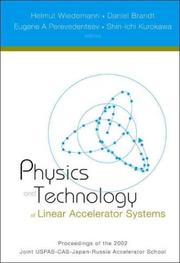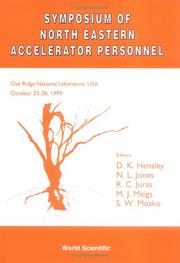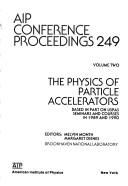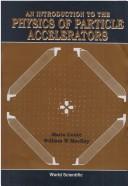| Listing 1 - 10 of 67 | << page >> |
Sort by
|
Book
ISBN: 9814583251 9789814583251 9814583243 9789814583244 Year: 2013 Publisher: Singapore
Abstract | Keywords | Export | Availability | Bookmark
 Loading...
Loading...Choose an application
- Reference Manager
- EndNote
- RefWorks (Direct export to RefWorks)
As particle accelerators strive forever increasing performance, high intensity particle beams become one of the critical demands requested across the board by a majority of accelerator users (proton, electron and ion) and for most applications. Much effort has been made by our community to pursue high intensity accelerator performance on a number of fronts. Recognizing its importance, we devote this volume to Accelerators for High Intensity Beams. High intensity accelerators have become a frontier and a network for innovation. They are responsible for many scientific discoveries and technologi
Particle accelerators. --- Accelerators, Particle --- Atom smashers --- Charged particle accelerators --- Nuclear physics --- Accelerator mass spectrometry --- Instruments

ISBN: 1281899062 9786611899066 9812703063 9812384634 9789812384638 9789812703064 9781281899064 Year: 2004 Publisher: River Edge, N.J. World Scientific
Abstract | Keywords | Export | Availability | Bookmark
 Loading...
Loading...Choose an application
- Reference Manager
- EndNote
- RefWorks (Direct export to RefWorks)
This book is useful to people working or planning to work in the field of linear accelerators. It is a good reference, presenting the most recent advances in the field. The intended audience are researchers, practitioners, academics and graduate students. The proceedings have been selected for coverage in:. Index to Scientific & Technical Proceedings (ISTP CDROM version / ISI Proceedings). CC Proceedings - Engineering & Physical Sciences.
Linear accelerators --- Particle accelerators. --- Accelerators, Particle --- Atom smashers --- Charged particle accelerators --- Nuclear physics --- Accelerator mass spectrometry --- Instruments
Book
ISBN: 9814383996 9789814383998 9814383988 9789814383981 Year: 2011 Publisher: Singapore World Scientific Pub. Co.
Abstract | Keywords | Export | Availability | Bookmark
 Loading...
Loading...Choose an application
- Reference Manager
- EndNote
- RefWorks (Direct export to RefWorks)
Since their debut in the late 1920s, particle accelerators have evolved into a backbone for the development of science and technology in modern society. Of about 30,000 accelerators at work in the world today, a majority is for applications in industry (about 20,000 systems worldwide). There are two major categories of industrial applications: materials processing and treatment, and materials analysis. Materials processing and treatment includes ion implantation (semi-conductor materials, metals, ceramics, etc.) and electron beam irradiation (sterilization of medical devices, food pasteurizati
Particle accelerators. --- Particle accelerators --- Accelerators, Particle --- Atom smashers --- Charged particle accelerators --- Nuclear physics --- Accelerator mass spectrometry --- Environmental aspects. --- Instruments

ISBN: 9812811729 9789812811721 9810244665 9789810244668 Year: 2001 Publisher: River Edge, NJ World Scientific
Abstract | Keywords | Export | Availability | Bookmark
 Loading...
Loading...Choose an application
- Reference Manager
- EndNote
- RefWorks (Direct export to RefWorks)
This volume includes papers about practical aspects of operating accelerators for a variety of purposes, from basic research to materials science. All discussions after the presentation of the papers are reproduced here. This is very helpful, as often the most important points are brought out in the discussions.
Particle accelerators --- Nuclear engineering --- Accelerators, Particle --- Atom smashers --- Charged particle accelerators --- Nuclear physics --- Accelerator mass spectrometry --- Design and construction --- Instruments
Book
ISBN: 365832726X 3658327251 Year: 2021 Publisher: Wiesbaden : Springer,
Abstract | Keywords | Export | Availability | Bookmark
 Loading...
Loading...Choose an application
- Reference Manager
- EndNote
- RefWorks (Direct export to RefWorks)
Particle accelerators. --- Particle accelerators --- Calibration. --- Accelerators, Particle --- Atom smashers --- Charged particle accelerators --- Nuclear physics --- Accelerator mass spectrometry --- Instruments
Book
ISBN: 9789264017344 Year: 2011 Publisher: Paris : OECD Publishing,
Abstract | Keywords | Export | Availability | Bookmark
 Loading...
Loading...Choose an application
- Reference Manager
- EndNote
- RefWorks (Direct export to RefWorks)
Particle accelerators have evolved over the last decades from simple devices to powerful machines, and are having an increasingly important impact on research, technology and daily life. Today they cover a wide range of applications including material science and medical applications. In recent years, requirements from new technological and research applications have emerged while the number of accelerator facilities in operation, being commissioned, designed or planned has significantly grown. Their parameters (such as the beam energy, beam currents and intensities, and target composition) vary widely, giving rise to new radiation shielding aspects and problems. Particle accelerators must be operated in safe ways to protect operators, the public and the environment. As the design and use of these facilities evolve, so must the analytical methods used in the safety analyses. These workshop proceedings review the state of the art in radiation shielding of accelerator facilities and irradiation targets. They also evaluate progress on the development of modelling methods used to assess the effectiveness of such shielding as part of safety analyses.
Shielding (Radiation) --- Particle accelerators --- Accelerators, Particle --- Atom smashers --- Charged particle accelerators --- Nuclear physics --- Accelerator mass spectrometry --- Nuclear shielding --- Radiation shielding --- Nuclear engineering --- Radioactivity --- X-rays --- Instruments --- Safety measures

ISBN: 0883187892 Year: 1992 Volume: 249 Publisher: New York (N.Y.) : American institute of physics,
Abstract | Keywords | Export | Availability | Bookmark
 Loading...
Loading...Choose an application
- Reference Manager
- EndNote
- RefWorks (Direct export to RefWorks)
Particle accelerators --- -#KVIV:BB --- Accelerators, Particle --- Atom smashers --- Charged particle accelerators --- Nuclear physics --- Accelerator mass spectrometry --- Congresses --- Instruments --- Congresses. --- #KVIV:BB

ISBN: 981020812X 9810208138 9789814439633 9814439630 9789810208127 1299280919 9781299280915 Year: 1994 Publisher: Singapore River Edge, N.J. World Scientific
Abstract | Keywords | Export | Availability | Bookmark
 Loading...
Loading...Choose an application
- Reference Manager
- EndNote
- RefWorks (Direct export to RefWorks)
This book provides a concise and coherent introduction to the physics of particle accelerators. It is written for students at the graduate level in physics and provides the elements to tackle the main problems regarding cyclic particle accelerators. In particular, a thorough introduction is given on the topics of such machines. Phase focusing is also fully treated, together with fundamental topics like synchrotron radiation and linear and nonlinear resonances. A chapter is devoted to rf linear accelerators and rf structures. The chapter on space charge effects deals with tune-shifts and beam-b
Book
ISBN: 9789814436397 9814436399 9814436402 Year: 2016 Publisher: Singapore: World scientific,
Abstract | Keywords | Export | Availability | Bookmark
 Loading...
Loading...Choose an application
- Reference Manager
- EndNote
- RefWorks (Direct export to RefWorks)
"The past 100 years of accelerator-based research have led the field from first insights into the structure of atoms to the development and confirmation of the Standard Model of physics. Accelerators have been a key tool in developing our understanding of the elementary particles and the forces that govern their interactions. This book describes the past 100 years of accelerator development with a special focus on the technological advancements in the field, the connection of the various accelerator projects to key developments and discoveries in the Standard Model, how accelerator technologies open the door to other applications in medicine and industry, and finally presents an outlook of future accelerator projects for the coming decades."--Provided by publisher.
Particle accelerators --- Colliders (Nuclear physics) --- Particle accelerators. --- Accelerators, Colliding-beam --- Colliding-beam accelerators --- Accelerators, Particle --- Atom smashers --- Charged particle accelerators --- Nuclear physics --- Accelerator mass spectrometry --- Instruments
Book
ISBN: 1783262788 9781783262786 1306496829 9781306496827 178326277X 9781783262779 9781783262779 Year: 2014 Publisher: London Singapore Imperial College Press Distributed by World Scientific Pub. Co.
Abstract | Keywords | Export | Availability | Bookmark
 Loading...
Loading...Choose an application
- Reference Manager
- EndNote
- RefWorks (Direct export to RefWorks)
Particle accelerators are essential tools for scientific research in fields as diverse as high energy physics, materials science and structural biology. They are also widely used in industry and medicine. Producing the optimum design and achieving the best performance for an accelerator depends on a detailed understanding of many (often complex and sometimes subtle) effects that determine the properties and behavior of the particle beam. Beam Dynamics in High Energy Particle Accelerators provides an introduction to the concepts underlying accelerator beam line design and analysis, taking an ap
Beam dynamics. --- Particle accelerators. --- Accelerators, Particle --- Atom smashers --- Charged particle accelerators --- Nuclear physics --- Accelerator mass spectrometry --- Beam blow-up --- Blowup (Particle beams) --- Dynamics --- Particle beams --- Instruments
| Listing 1 - 10 of 67 | << page >> |
Sort by
|

 Search
Search Feedback
Feedback About UniCat
About UniCat  Help
Help News
News